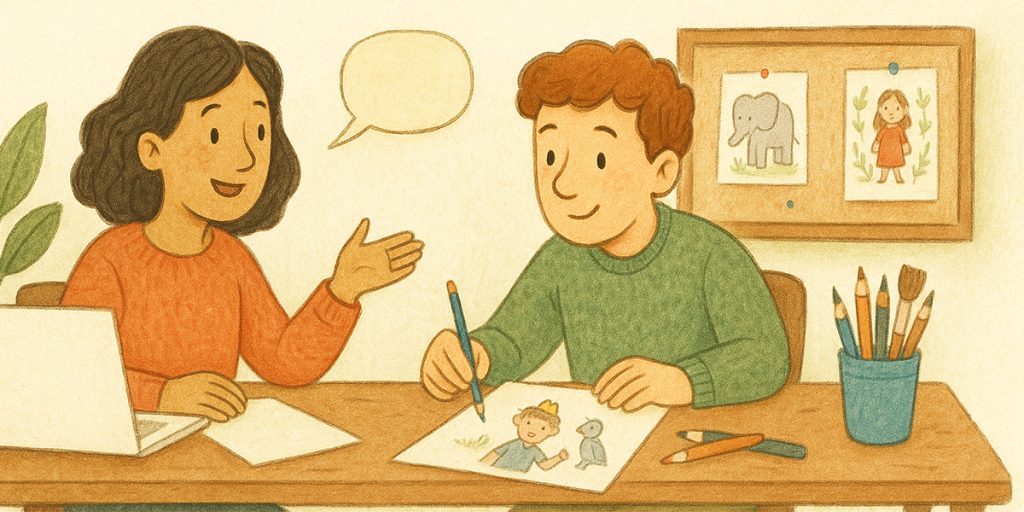Every great story begins with a character. Whether it’s a brave hero, a mischievous sidekick, or a gentle dreamer, characters are the heart of storytelling. But creating memorable characters goes beyond just giving them a face or a name.
In the world of storytelling and illustration, two vital processes shape every unforgettable figure — character design and character development. While these terms are often used interchangeably, they represent two different but equally important aspects of storytelling.
Let’s explore the difference between character design and character development, and why both are essential for bringing your characters—and your story—to life.
What Is Character Design?
Character design is the visual creation of a character how they look, dress, move, and express themselves. It’s the artistic process that turns an idea into a tangible visual representation.
A character designer focuses on:
- Facial features and expressions
- Body shape and proportions
- Clothing and accessories
- Color palette and style consistency
- Silhouettes and posture that reflect personality
For example, think of Elsa from Frozen — her ice-blue gown, braided hair, and elegant movements all communicate her calm, graceful, and powerful nature. Her design visually expresses who she is long before she speaks a word.
Character design answers the question: “What does this character look like?”
What Is Character Development?
Character development, on the other hand, focuses on the emotional, psychological, and narrative growth of a character throughout a story. It’s about who the character is on the inside their thoughts, motivations, flaws, and evolution as the plot unfolds.
A writer or storyteller shapes a character’s development by defining:
- Backstory and personal history
- Personality traits and flaws
- Goals, fears, and motivations
- Relationships and emotional arcs
- The journey of transformation or self-discovery
Key Differences Between Character Design and Character Development
While both processes create strong, believable characters, they serve different purposes in storytelling. Here’s how they differ:
| Aspect | Character Design | Character Development |
|---|---|---|
| Focus | Appearance, posture, and visual identity | Personality, emotions, and growth |
| Discipline | Art and illustration | Writing and storytelling |
| Goal | Make the character visually appealing and recognizable | Make the character relatable and emotionally real |
| Tools Used | Sketches, color palettes, design software | Dialogue, conflict, inner thoughts |
| When It Happens | Early in the visual creation process | Throughout the story arc |
A well-designed character may catch the eye, but a well-developed one captures the heart. The best stories combine both to create characters that look memorable and feel real.
Why Character Design Matters
In children’s books, animations, or illustrated novels, character design helps readers instantly connect with the story. A child might recognize a hero by their bright colors or a villain by their sharp features.
Good character design:
- Builds instant recognition
- Reflects personality through art
- Establishes tone and setting
- Creates emotional connection through visual cues
When done right, even a single glance at the character tells a story. This is why professional illustrators spend time sketching multiple versions before finalizing a design that perfectly aligns with the book’s theme.
Why Character Development Matters
While design hooks the reader, development keeps them invested. A beautifully drawn character means little if they don’t evolve or face meaningful challenges.
Character development allows readers to witness growth, transformation, and emotion — the elements that turn a story from entertaining to unforgettable.
In writing:
- A character must have goals and obstacles.
- They should change in response to the events around them.
- Readers should understand why they make their choices.
How Character Design and Development Work Together
The magic happens when design and development blend seamlessly. A strong collaboration between an author and illustrator ensures that a character’s appearance mirrors their inner journey.
For example:
- A brave young girl in an adventure story might start with simple clothing that becomes more detailed as her confidence grows.
- A shy character might be drawn with slouched posture at first, evolving into upright, bold body language by the end.
When the visuals support the character’s emotional arc, the audience experiences a deeper connection.
Tips for Creating Balanced Characters
If you’re an author or illustrator working on your next project, here are a few practical tips:
- Start with a character profile – define personality before design.
- Sketch multiple concepts – explore how different looks express emotion.
- Use symbolism in design – colors and shapes can reflect traits.
- Plan the arc – think about how the character will grow or change.
- Collaborate often – writers and illustrators should communicate regularly to ensure consistency.
When design and development complement each other, characters become more believable and stories more engaging.
Conclusion
The difference between character design and character development lies in the balance between what we see and what we feel. Design gives your character a face; development gives them a soul.
A visually stunning design will attract readers, but a deeply developed personality will keep them turning pages. The two go hand in hand, transforming stories into unforgettable experiences.
At The Rainbow Stories, we specialize in custom character design and development for children’s books, helping authors bring their imagination to life one story, one sketch, one emotion at a time.







